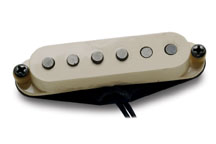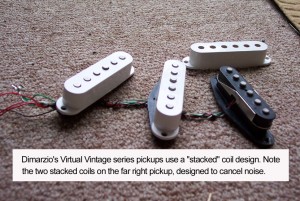With so many different types of pickups on the market, choosing one that’s just right for you can certainly be a challenge. For typical non-active pickups used in most guitars today, the materials used and how each pickup is constructed can make a large difference in the final tone achieved. Active pickups (i.e., those that have some form of pre-amplification built in that requires the use of a battery of some type) are a whole different category altogether.
For the sake of focus, this two-part series will discuss varieties of vintage style pickups. First, we’ll take a look at some single-coil options that you’d typically use in a Stratocaster. Next time, we’ll bring out the Les Paul and play with some vintage-voiced humbuckers. As we go through the various options, some vendors were kind enough to provide great educational info about how each pickup is made and why they’ll sound a particular way. This will be helpful for the person that may not necessarily be interested in a vintage-voiced pickup but can use the information to read over the specifications of another pickup and then perhaps get a better understanding of how each specification may affect the tone.
Seymour Duncan SSL-1 Stratocaster set: SRP $69 each
Our first set pickups we installed were the SSL-1 series Seymour Duncan pickups. The SSL-1s have staggered pole pieces like those found on all Stratocasters until late 1974 when the poles became “flush” or flat parallel with the pickup covers. Using Alnico V magnets again like majority of original Stratocaster pickups, the SSL-1s are essentially designed to be stock Stratocaster pickup replacements.
To get a bit more of an authentic tone, the magnets themselves go through what Seymour Duncan calls its “Dun-aged” process. The winding copper material, thick paper stock pickup back, and cloth push-back braided wire all reflect the styling and manufacturing quality of the originals.
Installing these pickups into our 1997 American Standard Stratocaster with rosewood fretboard, the tone of these pickups when run cleanly through various test amps can be described as sounding true to what a Strat pickup should sound like: bright, with a chiming and smooth tone in the bridge position with a warmer tone in the neck including a solid and tight emphasis of the lows. The middle position reflects a good balance of the two other positions but the 5-position selector switch also provides nice in-between position tones that can still cut through the mix.
When overdriving a guitar amp with the SSL-1s, as with any true and authentic Strat-type pickup, one has to pay careful attention to their amp rigs and e.q. appropriately. As many people know, a stock Stratocaster can be overly bright into some amps especially when they’re overdriven.
However, when comparing the SSL-1s to the factory flat-pole piece pickups previously installed in our Strat, it’s easy to hear thebetter overall fidelity that the SSL-1 set provides. If you’re looking for an improvement in Strat tone with a wider range of tone signal from bottom to top, the SSL-1s are a good choice.
Seymour Duncan Antiquity Set (Custom Bridge, RWRP – Reverse Wound-Reverse Polarity – Middle, Texas Hot at Neck) SRP: $100 each
I’m going to cut to the chase. The Seymour Duncan Antiquity series pickups that I tested had the best tone of any single-coil pickup that I’ve ever used. Going into a clean Fender Super Reverb amplifier as well as a Hiwatt Custom 100, the bridge position pickup chimes with the bell-like tones just like those that come from the best of the original Strats. However, unlike newer Strat pickups that can be overbearing at times with brightness, some of the highest frequencies are tapered off and the result is quite a musical and wonderfully balanced pickup. The neck and middle position are equally as stunning – the bottom end is nicely balanced on the neck with plenty of punch to the signal while the middle position has an even and basically flat response when you don’t want to overemphasize the lows or highs.
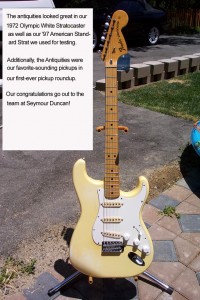 Overdriving the bridge pickup into the old Marshall Super Lead produces heavenly results. The Antiquity Custom Bridge model is plain and simply the smoothest-sounding single-coil I’ve ever heard overdriven into this environment. The highs are present and punchy but again, the harshest frequencies that sometimes sound a bit brash with single-coil pickups were gone.
Overdriving the bridge pickup into the old Marshall Super Lead produces heavenly results. The Antiquity Custom Bridge model is plain and simply the smoothest-sounding single-coil I’ve ever heard overdriven into this environment. The highs are present and punchy but again, the harshest frequencies that sometimes sound a bit brash with single-coil pickups were gone.
The Antiquity series is quite a special one. These are produced by hand from Seymour’s own workshop, wound to his specifications and have appropriately aged magnets, wire and pickup covers. There is definitely some magic in this process judging from the tone and I heard and for those seeking authentic vintage Strat tone with a little bit more power and smoothness for blues or classic rock, these are the pickups to go for. Recommended by us, I should say, and with no hesitations!
DiMarzio Virtual Vintage Series (model 2.2 at Neck and Middle position, Solo model at Bridge) SRP: $99 each
I was excited at the prospect of checking out the DiMarzio Virtual Vintage series. The promise: Various classic vintage Fender tones with low noise due to a hum-cancelling (a.k.a. stacked-coil) design. I was first introduced to stacked pickups like these when DiMarzio put out the HS-3 model years ago. By pure definition, these are all humbucking pickups by design rather than single coil, since there are two coils and each coil is placed on top of one another rather than side-by-side in a humbucker. However, they are made to fit into a single coil space and cosmetically look identical to any other single-coil pickup.
In terms of noise or interference from high-energy lighting systems, etc. I never had a problem with the HS-3’s over the years. Tonewise, they weren’t the perfect pickup but I didn’t want to deal with the hum and problems with a single coil. The tradeoff with these stacked-coil design was quite honestly a tonal one. The HS-3s were a bit muffled in the highs and had a bottom end and midrange that just didn’t have the attack and clarity of a good single-coil pickup. But with that said, if you aren’t concerned with retaining the classic Strat tone as I wasn’t for many years, then certainly the coloration offered by the HS-3s may be suited to you just fine.
My impression of the Virtual Vintage series as a whole is that these are much more accurate to the vintage type tones as compared to the earlier HS-3. In fact, I was quite pleased with this set, especially when run against an amp set clean. Some of the top-end sparkle is still lacking and there is added low-end typical for a humbucker, but for some people that may have an overly bright Fender amp and want to reduce the noise or possibility of hum/interference, DiMarzio’s Virtual Vintage series does a good job. For the absolute vintage tone connosieur dead-set on getting accurate tones, dealing with the possibility of a little hum and going for a single-coil set would likely be a better bet however.
One area where this series seemed to be of help to me was when I ran loads of distortion or fuzz or a good deal of processing. Any hum that would have been transferred by another pickup would have been amplified greatly through a stompbox. In the case of the Virtual Vintage series, that was one issue I was able to avoid.
Fender Custom Shop Fat 50’s set, SRP $224.99 (set of 3)
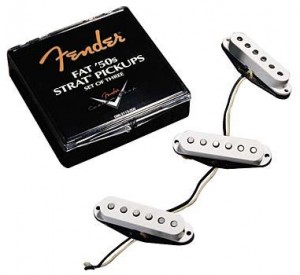 Fender’s Custom Shop single coils were reintroduced and brought out to very good reviews. The original folks that wound the pickups back in the day are apparently back on staff doing them again. Cosmetically, these are the familiar grey-bottom single-coil design pickups and use Alnico V magnets wire just like the originals.
Fender’s Custom Shop single coils were reintroduced and brought out to very good reviews. The original folks that wound the pickups back in the day are apparently back on staff doing them again. Cosmetically, these are the familiar grey-bottom single-coil design pickups and use Alnico V magnets wire just like the originals.
Sonically, these sound in between the Seymour Duncan SSL-1’s and the Antiquities with the output similar to the antiquity but a little more brightness closer to the SSSL-1s in emphasis. In a clean environment, or when overdriven, the Custom Shop set responded with a snappy attack and biting tone that could only come from a Stratocaster.
Fender’s certainly done a nice job with these pickups which are OEM on some Custom Shop models as well.
Lace Sensor (Gold): SRP $72.99 each
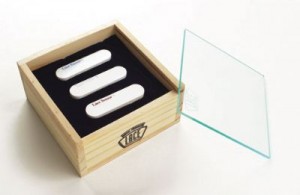 I was introduced to Lace sensors in the mid ‘90s. These were original equipment on Fender Stratocaster Plus models. The Lace sensors internally have a completely different construction and technology that enables a few interesting benefits for players. First, because the sensors sense vibrations in a non-magnetic fashion to transfer the signal from the strings, one can adjust the pickups at any height and not worry about excessive magnetic “pull” on the strings. Secondly, the sensors aren’t prone to noise or hum and are essentially as quiet as a common humbucker.
I was introduced to Lace sensors in the mid ‘90s. These were original equipment on Fender Stratocaster Plus models. The Lace sensors internally have a completely different construction and technology that enables a few interesting benefits for players. First, because the sensors sense vibrations in a non-magnetic fashion to transfer the signal from the strings, one can adjust the pickups at any height and not worry about excessive magnetic “pull” on the strings. Secondly, the sensors aren’t prone to noise or hum and are essentially as quiet as a common humbucker.
Unlike standard pickups, the Lace Sensors I tested didn’t have pole pieces and instead are simply housed in non-holed pickup covers. For those that want the traditional Strat “look”, these aren’t the right pickups to choose, but for quiet Strat operation and tone, the gold Lace sensors do a remarkable job.
The gold Lace sensors are just one variation and are modeled after the original Strat type pickups and have lower output but plenty of chime and sparkle with the famous Stratocaster bell-like tones. Other models are available in other outputs (silver and blue) all the way up to the hottest output red Lace sensors.
Sonically, the gold Lace sensors do a very close representation of the early original Strat pickups. If your needs call for a good Stratocaster pickup with as accurate of a vintage tone as possible but with the benefits of lower noise, the gold Lace sensors are a great choice.
